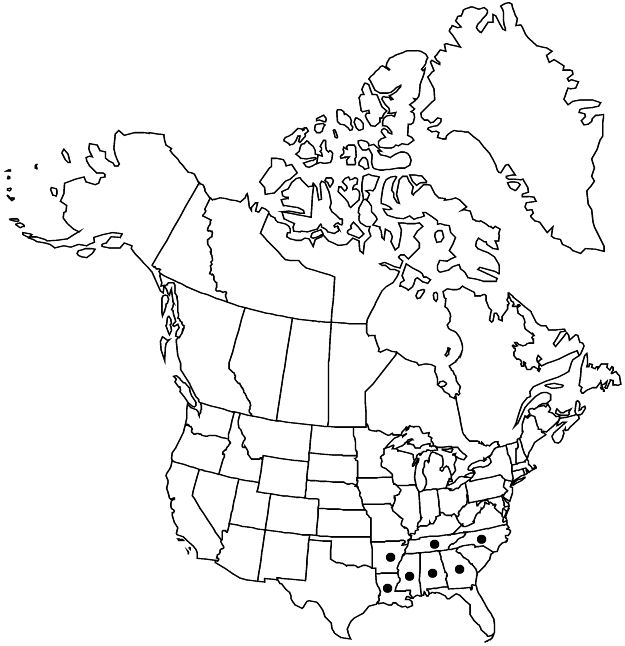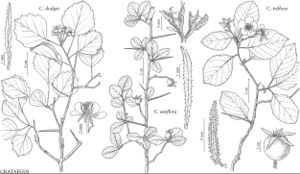Crataegus triflora
Fl. South. U.S. ed. 2 repr. 2, 684. 1892.
Shrubs, 20–50 dm, multi-stemmed. Stems: compound thorns on trunks present; twigs: new growth appressed-pubescent, 1–2-years old brown, older gray; thorns on twigs ± straight, 2-years old dark gray or blackish, ± thin, 2–4 cm. Leaves: blade broadly elliptic, 3–8(–10) cm, base cuneate to rounded or truncate, entire or lobes 1–3(or 4) per side, sinuses shallow, lobe apex subacute to acute, margins serrulate teeth 1 mm, 10 per cm, gland-tipped, veins 5–7 per side, apex acute, abaxial surface pubescent young, only abaxial veins pubescent when old, adaxial appressed-pubescent young. Inflorescences 2–6(–12)-flowered, on leafy short shoots of season, arising lateral to extension shoots, also from woody short shoots; bracteoles caducous to semipersistent, membranous to herbaceous. Flowers 25–30 mm diam.; sepals triangular, 8–10 mm; stamens 30–45(–47); styles 4. Pomes ruddy to deep or bright red, sometimes coral red, suborbicular to obovoid. 2n = 34, 51, 68.
Phenology: Flowering late Apr–early May; fruiting Sep–Nov.
Habitat: Hardwood gaps, pine forests, cattle-grazed scrub on blackland soil, prairie margins
Elevation: 0–200 m
Distribution

Ala., Ark., Ga., La., Miss., N.C., Tenn.
Discussion
Records of Crataegus triflora from Virginia probably refer to C. ×vailiae.
Crataegus triflora is usually an open-grown, multi-stemmed, rather lax shrub. A fairly rare, quite distinctive morph from central Mississippi has more or less ovate leaves that sometimes have nearly truncate bases and larger marginal teeth than the typical form. Tennessee plants usually have proportionately wide leaves with unusually large marginal teeth. Anomalous populations from Caldwell Parish, Louisiana, have much smaller leaves and flowers as in C. ashei but retain the large stamen number. Vegetative specimens with smallish leaves with lobes absent may resemble C. collina but are easily distinguished by their highly glandular leaf margins and petioles.
Crataegus triflora often produces inflorescences on 2–5 cm peduncles of the season that arise laterally from extension shoots, instead of from woody short shoots as is usual among hawthorn species. Such a feature is also found in ×Crataemespilus canescens (J. B. Phipps) J. B. Phipps. Crataegus triflora flowers are among the most spectacular in the genus, their size reminiscent of a wild rose, and the inflorescences may be much more floriferous then the name suggests. Ploidy level determinations by N. Talent and T. A. Dickinson (2005) suggested that tetraploidy and triploidy are common but that diploidy is rare in C. triflora.
Selected References
None.
